By Nicki Richesin, The Children’s Book Review
Published: October 6, 2011
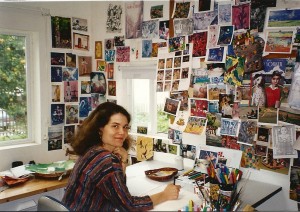
Elisa Kleven has created magical, fantastic worlds for children to explore in her acclaimed picture books including such gems as The Paper Princess, The Lion and The Little Red Bird, Welcome Home, Mouse, and A Carousel Tale. An author and illustrator, she employs an unusual mixed-media technique of watercolor, collage and illustration to create her fantasy landscapes. Her most recent titles include The Friendship Wish and One Little Chicken. The Friendship Wish tells the story of lonely dog named Farley who dreams of an angel and enlists his “friends” to help him find her when he awakes. For One Little Chicken, Kleven returned to her Russian-Jewish roots to illustrate this folktale about a little girl named Leora who finds a chicken and wants to keep it, but her parents insist on keeping it only until its rightful owner returns. Although Jewish law dictates that “finders aren’t keepers,” this delightful tale is a great lesson on generosity. Kleven lives in the San Francisco Bay Area with her husband, daughter, son, and various animal friends.
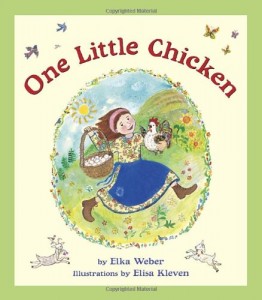 Nicki Richesin: You have created some unforgettable picture books over the years including The Paper Princess series, Sun Bread, Ernst, and The Apple Doll. Would you tell us a little about your work on your latest book One Little Chicken?
Nicki Richesin: You have created some unforgettable picture books over the years including The Paper Princess series, Sun Bread, Ernst, and The Apple Doll. Would you tell us a little about your work on your latest book One Little Chicken?
Elisa Kleven: Although I’ve created pictures for quite a few stories and songs about Christmas, and many books with Latin American themes, One Little Chicken, by Elka Weber, is the first Jewish story that I’ve illustrated. Being of Russian-Jewish descent myself, the story seemed a natural fit for me. My ancestors come from the same kind of “shtetl,” or little Jewish town, in the story, and I grew up hearing a Passover song about a certain “father” who “bought a goat for two zuzim” (silver coins), which is just what the father in the book does!
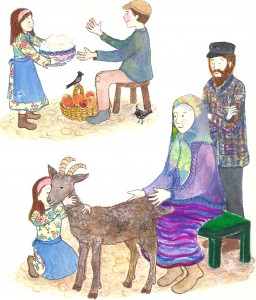
Furthermore, as an ardent admirer of goats (I love their sweet smiles, graceful legs, intelligent, soulful eyes, mischievousness — everything about them!) I was delighted at the prospect of illustrating a book in which they feature prominently. While illustrating One Little Chicken I made many trips to “The Little Farm” in Berkeley’s Tilden Park, not far from my house. Many goats—and chickens!— call this peaceful place home and it was a lovely location to draw inspiration for my illustrations and, literally, to draw goats!
All of your books have a deep connection to the natural world and a strong sense of community. Also, flying characters take to the sky in many of them. Growing up in Los Angeles, you’ve said you felt deprived of nature and longing to live in the fantastic worlds, like Oz and Neverland, you read about in books. Having created so many magical picture books, I wonder if you still feel the same way you did as a child or if you’ve satisfied that desire by creating these rich dreamscapes for children to imagine?
No, I’m still searching for magical, undiscovered places, and using my humble art supplies—paper, paint, pencils, scraps, glue—to help me find them. My stories usually start with a kind of ache—for magic, for beauty, for the lost world of childhood itself, when life was experienced with so much intensity and wonder.
Although you’ve had little formal training, you employ a broad range of materials and your work is truly stunning. Both your mother and grandmother were artists and encouraged your creativity. Do you feel they’ve influenced your work in a profound way?
Yes! I grew up with a mother who made art every day. She was a professional print maker and etcher, with a bold unconventional vision. She loved to scavenge junk yards for weird pieces metal and textured wire which she would later transform into new shapes. And though her work was very sophisticated, and often dark and political (in contrast to my colorful, “naïve” approach) I share her passion for recycling and transforming collage materials.
Likewise, my maternal grandmother was very creative. She was a sculptor who transformed clay into beautiful sculptures of the people and animals she had known, both as a child in a shtetl in Ukraine, and later as an adult. My grandma and my mother both loved to take my siblings and me to museums, and both had great collections of art books which I’d gaze at for hours. And they always gave me art supplies for gifts (even though I secretly longed for Barbie dolls!)
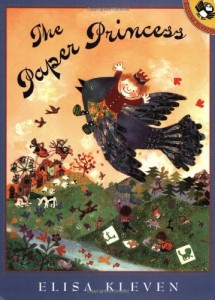 I know The Paper Princess is a very personal book for you as you also drew and cut out small people and animals as a child. The book has inspired a play touring in Ireland with Monkeyshine Theatre and also a musical The Paper Princess and the Piñata. Could you tell us a bit about your collaboration with the directors of these productions to produce a musical and a play based on your book?
I know The Paper Princess is a very personal book for you as you also drew and cut out small people and animals as a child. The book has inspired a play touring in Ireland with Monkeyshine Theatre and also a musical The Paper Princess and the Piñata. Could you tell us a bit about your collaboration with the directors of these productions to produce a musical and a play based on your book?
Last spring was a busy season for The Paper Princess. It was purely coincidental that the San Rafael based group Youth in Arts and the Irish company Monkeyshine Theatre both produced plays based on my story.
The director for the Irish play emailed me and asked if she could use the text as the basis for her production. She said she had stumbled upon the book in a small shop and that, while she usually based her children’s productions on “classics,” The Paper Princess resonated with and inspired her — a great honor for me. After her initial inquiry I wasn’t involved with the production, though I was delighted to see photos of the enchanting final creation. The play was also performed in Norway, at an international festival within the Arctic Circle. I loved the thought of my paper doll flying so far and wide…
As for the Youth in Arts production, The Paper Princess and the Piñata, director Miko Lee really kept me in the loop. She met with me periodically to discuss how the company was spinning songs, dances, and theater from the picture book. As with the Irish production, I can’t take credit for any of the company’s amazing work, though I did paint a few giant Paper Princesses, which were used by the actors in the play. But other than that I just sat back and watched my baby being translated into beautiful theater and music and dance!
You’ve spoken in other interviews about your childhood influences like Laura Ingalls Wilder, E.B. White and Hans Christian Andersen. Which artists or authors inspire you now?
I always have trouble answering these kinds of questions. I think I am a giant sponge who is inspired by everything I like or love, from my dog prancing in the park to the limitless imaginations of Picasso or J.K. Rowling. (At least I hope I’m inspired by these geniuses — maybe awestruck is a better word.) But seriously, I admire so many children’s book creators. Here, for example, and somewhat randomly, are some of my favorites with last names beginning with “S”: Maurice Sendak, Uri Schulevitz, Meilo So, William Steig, Dan San Souci, Stacey Schuett, Lane Smith, Peter Sis…and probably a gazillion others that I’m missing. And those are just the “S”es.
Could you please tell us about the books you’re currently working on or we can expect to read soon?
I am currently illustrating a story I wrote about a butterfly. (Dial Children’s Books will publish it sometime next year, I believe.) There are some gritty urban scenes in the book, and I’m enjoying the challenge of using fewer “pretty” colors for these pictures.
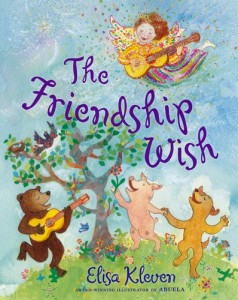 My newest published book is The Friendship Wish, which comes out in a few weeks. It tells the story of Farley, the new dog in the neighborhood, who tries to make friends with his very busy neighbors. Feeling rebuffed and lonely, Farley dreams of a sparkly, starry angel, who sings and dances with him, and makes him crispy golden pancakes. Upon awakening, Farley searches for his lovely angel. His neighbors join him, and together they …well, become friends. Does Farley find his angel? Read the book and find out!
My newest published book is The Friendship Wish, which comes out in a few weeks. It tells the story of Farley, the new dog in the neighborhood, who tries to make friends with his very busy neighbors. Feeling rebuffed and lonely, Farley dreams of a sparkly, starry angel, who sings and dances with him, and makes him crispy golden pancakes. Upon awakening, Farley searches for his lovely angel. His neighbors join him, and together they …well, become friends. Does Farley find his angel? Read the book and find out!
The book was inspired by my favorite play, The Tempest. Caliban, the “monster” in the play tells of his beautiful, musical dreams of “a thousand twangling instruments” and of “riches ready to drop upon him” and how, upon waking, he “cried to dream again.” The line “I cried to dream again” gives me that achy feeling I mentioned before. It contains that longing for a lost, shimmering world, just out of reach — a dreamscape which can only be imitated, not fully re-created, in art (and in Farley’s case, music, dance and friendship.)
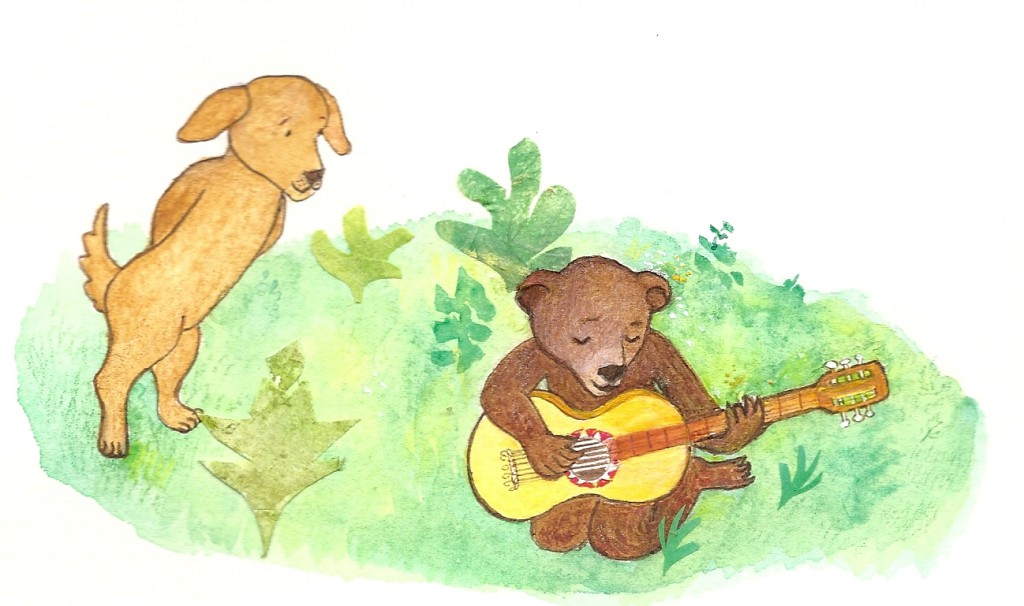
And speaking of The Friendship Wish, I have to add that I’m still getting used to the title, which was assigned very late in the game by my publisher. They weren’t satisfied with the names I’d suggested (e.g. What Pup Dreamed Up, Friends For Farley, and Angel Pancakes), so they re-named it. I hope that people will like the title The Friendship Wish, though I must confess that I’m still getting used to it!
For more information, visit: http://www.elisakleven.com/
Nicki Richesin is the editor of four anthologies,What I Would Tell Her: 28 Devoted Dads on Bringing Up, Holding On To, and Letting Go of Their Daughters; Because I Love Her: 34 Women Writers Reflect on the Mother-Daughter Bond; Crush: 26 Real-Life Tales of First Love; and The May Queen: Women on Life, Work, and Pulling it all Together in your Thirties. Her anthologies have been excerpted and praised in The New York Times, the San Francisco Chronicle,The Boston Globe, Redbook, Parenting, Cosmopolitan, Bust, Daily Candy, and Babble.

1 Comment
The only website I have at this point is my Friendly Farm Website. This is my 48th year in teaching and 65th year as a framer. I’m new to writing. The book I have written is about Hairyit, who leaves a mountain ranch in the California foothills and comes to a farm. This is a huge adjustment for Hairyit and the resident livestock on the farm. I’m looking for an illustrator.
Many thanks for your kind consideration,
Dotty Bergmen